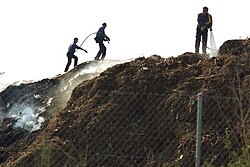
Compost is a mixture of ingredients used as plant fertilizer and to improve soil's physical, chemical, and biological properties. It is commonly prepared by decomposing plant and food waste, recycling organic materials, and manure. The resulting mixture is rich in plant nutrients and beneficial organisms, such as bacteria, protozoa, nematodes, and fungi. Compost improves soil fertility in gardens, landscaping, horticulture, urban agriculture, and organic farming, reducing dependency on commercial chemical fertilizers. [1] The benefits of compost include providing nutrients to crops as fertilizer, acting as a soil conditioner, increasing the humus or humic acid contents of the soil, and introducing beneficial microbes that help to suppress pathogens in the soil and reduce soil-borne diseases.
Contents
- Fundamentals
- Organisms
- Phases of composting
- Hot and cold composting – impact on timing
- Pathogen removal
- Diseases that can be contracted from handling compost
- Environmental benefits
- Materials that can be composted
- Organic solid waste
- Animal manure and bedding
- Human excreta
- Animal remains
- Composting technologies
- Industrial-scale composting
- Other systems at household level
- Related technologies
- Uses
- Agriculture and gardening
- Other
- Regulations
- History
- See also
- Related lists
- References
At the simplest level, composting requires gathering a mix of green waste (nitrogen-rich materials such as leaves, grass, and food scraps) and brown waste (woody materials rich in carbon, such as stalks, paper, and wood chips). [1] The materials break down into humus in a process taking months. [2] Composting can be a multistep, closely monitored process with measured inputs of water, air, and carbon- and nitrogen-rich materials. The decomposition process is aided by shredding the plant matter, adding water, and ensuring proper aeration by regularly turning the mixture in a process using open piles or windrows. [1] [3] Fungi, earthworms, and other detritivores further break up the organic material. Aerobic bacteria and fungi manage the chemical process by converting the inputs into heat, carbon dioxide, and ammonium ions.

Composting is an important part of waste management, since food and other compostable materials make up about 20% of waste in landfills, and due to anaerobic conditions, these materials take longer to biodegrade in the landfill. [4] [5] Composting offers an environmentally superior alternative to using organic material for landfill because composting reduces methane emissions due to anaerobic conditions, and provides economic and environmental co-benefits. [6] [7] For example, compost can also be used for land and stream reclamation, wetland construction, and landfill cover.


















